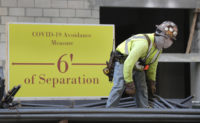Everyone talks about the construction industry’s COVID-19 new normal, but what exactly should that be? A construction jobsite is neither a fine-tuned symphony orchestra nor a freestyle musical jam session. That workplace, comprising numerous employers in a variety of fields with many differently skilled professionals, is not as regimented as a meatpacking plant, but it’s not a totally disorganized competition for space and resources either.
With the project as focus, the owner and prime contractor determine cost and schedule, manage the different elements and set the overall tone. Each company involved must keep abreast of work progress, staffing levels, billings and payments. The pandemic emergency again proves the importance of professionalism from all participants in tracking costs so the bottom-line impact of added safety measures is clear up and down the project management chain. The question of who will pay for these—and for what has been and could continue to be a slower pace of work—will be tough to answer.
For ENR’s latest coverage of the impacts of the COVID-19 pandemic, click here
ENR’s tabulation of virus-affected jobsite practices across the U.S. shows that, in all but a handful of states, construction has resumed following a brief pause or after having never been completely stopped. But the situation still is changing. While Washington state was hard-hit on the West Coast—though not as badly as New York on the East—Gov. Jay Inslee (D) on March 25 clarified his “Stay Home, Stay Healthy” proclamation by saying no construction was considered essential. Four weeks later, after talking to unions and construction groups, Inslee announced a plan to restart low-risk construction—even amid a state stay-at-home order that remains in place until May 4. Differences across state lines, and from city to city, are proving important for companies working in multistate regions.
As Georgia unshutters its hair salons and tattoo shops, and Florida prepares to reopen beaches and recreational spots, the country must watch carefully the easing of shutdown and shelter-at-home edicts. The fervor to restart hard-hit local businesses could undermine long-term recovery of the U.S. economy if it triggers a bigger virus rebound this fall and winter. That could lead to renewed shelter-in-place rules and more business and project shutdowns that could inflict added economic damage and choke off public confidence that must be rebuilt before all sectors—especially travel, hospitality and entertainment—can resume.
The world economy will bear COVID-19 scars for years. But construction’s resourcefulness in finding new ways to design and exchange information and in displaying common sense to pause work and respect those who feel unsafe in reporting to a jobsite will be seen as highlights in an emergency that has revealed many heroes but not always brought out America’s best. Hopefully, those worth emulating include firms that shut down their own work, forfeiting revenue, until safety issues were resolved. Any study of the national response should make construction an example, and the industry should welcome the scrutiny. It could determine whether new safety practices must remain longer and if construction’s ability to adapt quickly to the new normal will allow a phasing-in of procedures that can be implemented as required.






Post a comment to this article
Report Abusive Comment